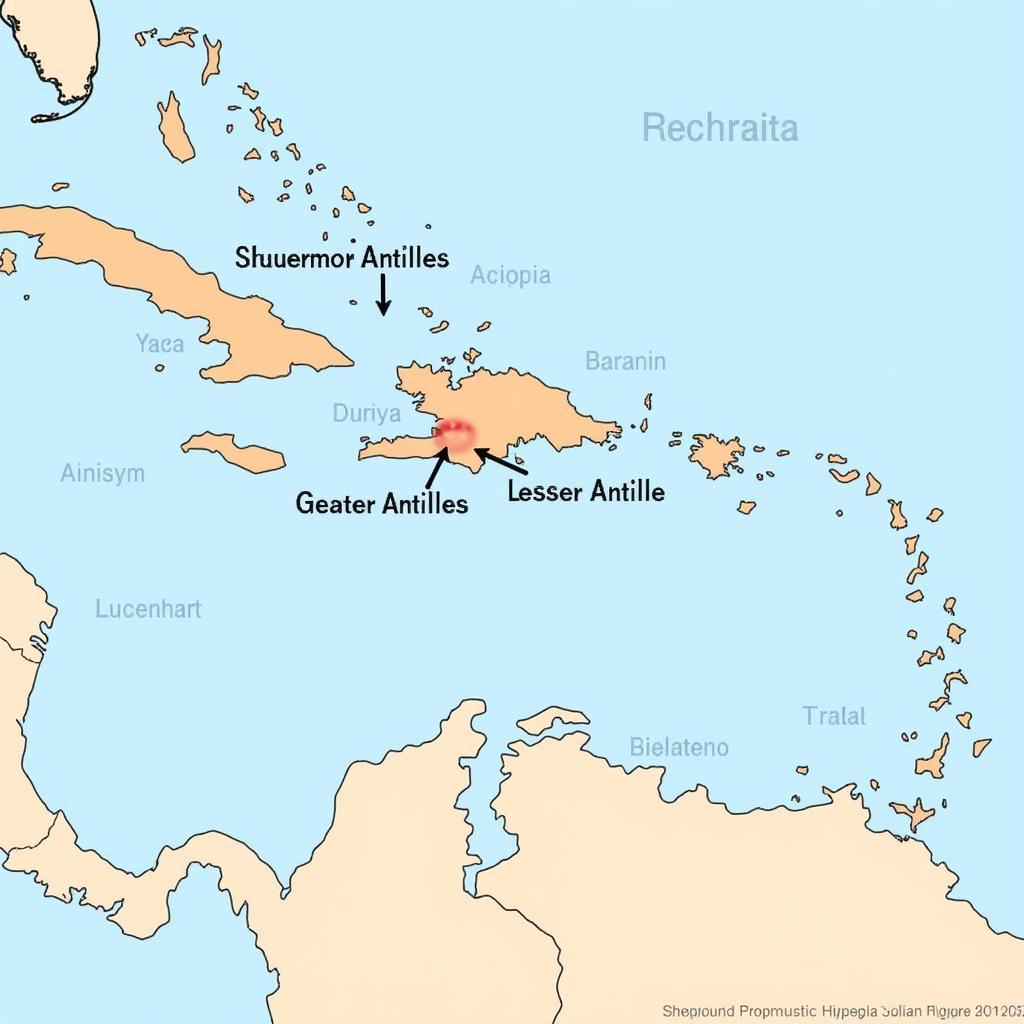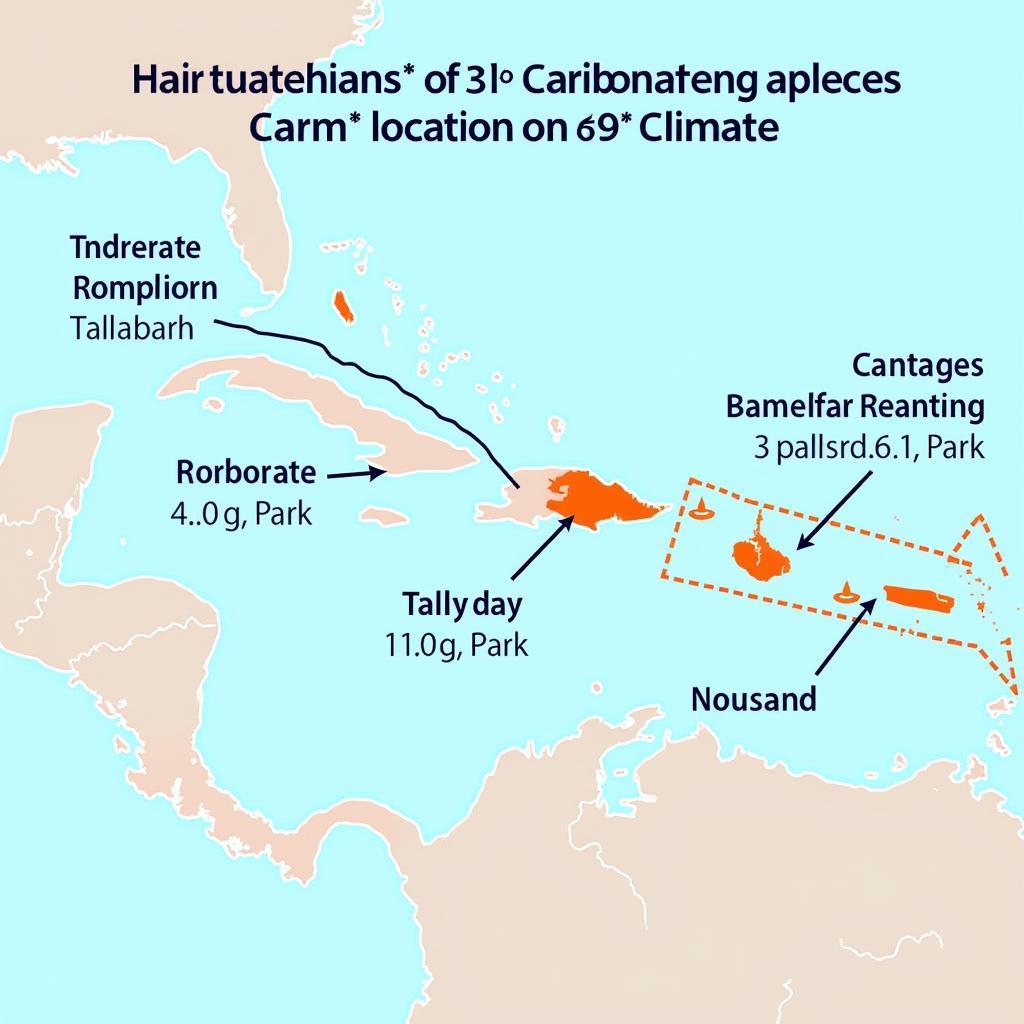The Caribbean, a vibrant tapestry of islands, turquoise waters, and rich culture, is located southeast of the Gulf of Mexico and the North American mainland, east of Central America, and north of South America. But where exactly is it, and what makes it so unique? This guide delves into the specifics of the Caribbean’s location, its diverse geography, and why it remains a top travel destination.
Unveiling the Caribbean’s Geographic Coordinates
The Caribbean isn’t just one island; it’s an archipelago encompassing numerous islands, islets, reefs, and cays. These are broadly divided into three main groups: the Greater Antilles, the Lesser Antilles, and the Lucayan Archipelago. Defining the exact boundaries can be tricky, but generally, the Caribbean Sea stretches from about 9°N to 22°N latitude and from 89°W to 60°W longitude. This positioning places it firmly within the tropics, contributing to its warm climate and lush vegetation.
 Caribbean Islands Map Showing Location
Caribbean Islands Map Showing Location
Exploring the Caribbean Islands: More Than Just Beaches
While the Caribbean is renowned for its stunning beaches, the region boasts a diverse geography, from volcanic peaks and rainforests to dry scrublands and coral reefs. The islands themselves vary significantly in size and topography. The Greater Antilles, comprising Cuba, Hispaniola (Haiti and the Dominican Republic), Jamaica, and Puerto Rico, are the largest islands. The Lesser Antilles, a sweeping arc of smaller islands from the Virgin Islands south to Trinidad and Tobago, showcase volcanic activity and lush tropical landscapes. Finally, the Lucayan Archipelago, comprising the Bahamas and the Turks and Caicos Islands, is known for its low-lying coral islands and pristine waters.
Why is Knowing the Caribbean’s Location Important?
Understanding the Caribbean’s geographic location is crucial for several reasons. It explains the region’s climate, influences its biodiversity, and shapes its cultural heritage. The Caribbean’s tropical location results in warm temperatures year-round, making it an attractive destination for travelers seeking sun and relaxation. Its proximity to various continents has contributed to a melting pot of cultures, blending indigenous traditions with European, African, and Asian influences.
 Caribbean Climate Influence of Location
Caribbean Climate Influence of Location
Caribbean’s Climate and Its Relation to Location
The Caribbean’s location within the tropics means it experiences a warm, tropical maritime climate. This translates to generally warm temperatures year-round, averaging between 75 and 85 degrees Fahrenheit (24 and 29 degrees Celsius). However, the islands are also susceptible to hurricanes, particularly during the Atlantic hurricane season, which typically runs from June to November. The Caribbean’s location within the hurricane belt is a direct consequence of its geographic coordinates.
Navigating the Caribbean: How to Get There
Getting to the Caribbean is relatively easy, with numerous international airports serving the islands. Many major airlines offer direct flights from North America, Europe, and South America. Alternatively, cruises are a popular way to explore the region, allowing you to island-hop and experience a variety of destinations.
 Caribbean Travel Options Air and Sea
Caribbean Travel Options Air and Sea
Conclusion
The Caribbean, situated southeast of the Gulf of Mexico and nestled between North and South America, is more than just a collection of beautiful islands. Its precise location dictates its climate, influences its rich biodiversity, and shapes its unique cultural tapestry. Whether you are drawn to its stunning beaches, vibrant culture, or thrilling adventures, the Caribbean offers an unforgettable experience.
FAQs
- What are the main island groups in the Caribbean? The Greater Antilles, the Lesser Antilles, and the Lucayan Archipelago.
- When is the hurricane season in the Caribbean? Typically from June to November.
- What is the average temperature in the Caribbean? Between 75 and 85 degrees Fahrenheit (24 and 29 degrees Celsius).
- How can I travel to the Caribbean? By air or by sea (cruise).
- What is the Caribbean known for? Beaches, warm climate, and diverse culture.
- What are some of the largest islands in the Caribbean? Cuba, Hispaniola (Haiti and the Dominican Republic), Jamaica, and Puerto Rico.
- What is the significance of the Caribbean’s location? It influences its climate, biodiversity, and cultural heritage.
Need Help Planning Your Caribbean Adventure?
Contact TRAVELCAR for all your transportation needs in Hanoi, Vietnam and beyond. We can help you organize airport transfers, city tours, and even plan exciting excursions.
Phone: 0372960696
Email: TRAVELCAR[email protected]
Address: 260 Cầu Giấy, Hà Nội.
We have a 24/7 customer service team.
Explore other articles on our website for more travel tips and inspiration. Are you interested in learning about [insert related topic]? Or maybe you’d like to discover [insert another related topic]? Let us help you plan your next unforgettable journey!

